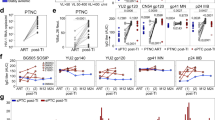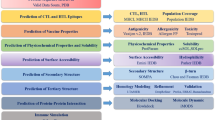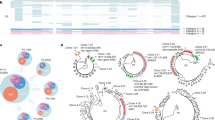Abstract
The precise role played by HIV-specific cytotoxic T lymphocytes (CTL) in HIV infection remains controversial. Despite strong CTL responses being generated during the asymptomatic phase, the virus persists and AIDS ultimately develops. It has been argued that the virus is so variable, and the virus turnover so great that escape from CTL recognition would occur continually, but so far there is limited evidence for CTL escape. The opposing argument is that evidence for CTL escape is present but hard to find because multiple anti-HIV immune responses are acting simultaneously during the asymptomatic phase of infection. We describe six donors who make a strong CTL response to an immunodominant HLA-B27-restricted epitope. In the two donors who progressed to AIDS, CTL escape to fixation by the same mutation was observed, but only after 9–12 years of epitope stability. CTL escape may play an important role in the pathogenesis of HIV infection.
This is a preview of subscription content, access via your institution
Access options
Subscribe to this journal
Receive 12 print issues and online access
$259.00 per year
only $21.58 per issue
Buy this article
- Purchase on SpringerLink
- Instant access to full article PDF
Prices may be subject to local taxes which are calculated during checkout
Similar content being viewed by others
References
Koup, R.A. et al. Temporal association of Cellular immune responses with the initial control of viremia in primary HIV-1 syndrome. J. Virol. 68, 4650–4655 (1994).
Borrow, P., Lewicki, H., Hahn, B.E., Shaw, G.M. & Oldstone, M.B. Virus-specific CD8+ CTL activity associated with control of viremia in primary HIV-1 infection. J. Virol. 68, 6103–6110 (1994).
Pantaleo, G. et al. Major expansion of CD8+ T Cells with a predominant Vβ usage during the primary immune response to HIV. Nature 370, 463–467 (1994).
Carmichael, A., Jin, X., Sissons, P. & Boryziewicz, L. Quantitative analysis of tHIV-1-specific cytotoxic T lymphocyte response at different stages of HIV-1 infection: Differential CTL responses to HIV-1 and EBV in late disease. J. Exp. Med. 177, 249–256 (1993).
Rinaldo, C. et al. High levels of anti-HIV-1 memory cytotoxic T lymphocyte activity and low viral load are associated with lack of disease in HIV-1 infected long-term nonprogressors. J. Virol. 69, 5838–5842 (1995).
Klein, M.R. et al. Kinetics of gag-specific cytotoxic T lymphocyte responses during the clinical course of HIV-1 infection: A longitudinal analysis of rapid progressors and long-term asymptomatics. J. Exp. Med. 181, 1365–1372 (1995).
Moss, P.A.H. et al. Persistent high frequency of HIV-specific cytotoxic T Cells in peripheral blood of infected donors. Proc. Natl. Acad. Sci. USA. 92, 5773–5777 (1995).
Phillips, R.E. et al. Human immunodeficiency virus genetic variation that can escape cytotoxic T Cell recognition. Nature 354, 453–459 (1991).
Nowak, M.A. et al. Antigenic oscillations and shifting immunodominance in HIV-1 infections. Nature 375, 606–611 (1995).
Couillin, I. et al. Impaired CTL recognition due to genetic variations in the main immunogenic region of the HIV-1 Nef protein. J. Exp. Med. 180, 1129–1134 (1994).
Koenig, S. et al. Transfer of HIV-1-specific cytotoxic T lymphocytes to an AIDS patient leads to selection of mutant HIV variants and subsequent disease progression. Nature Med. 1, 330–336 (1995).
Meyerhans, A. et al. In vivo persistence of an HIV-1-encoded HLA-B27-restricted cytotoxic T lymphocyte epitope despite specific in vitro reactivity, Eur. J. Immunol. 21, 2637–2640 (1991).
Harrer, T. et al. Cytotoxic T lymphocytes in asymptomatic long-term nonprogressing HIV-1 infection. J. Immunol. 156, 2616–2623 (1996).
Nietfeld, W. et al. Sequence constraints and recognition by CTL of an HLA-B27-restricted HIV-1 gag epitope. J. Immunol. 154, 2188–2197 (1995).
Bevan, M. & Braciale, T.J. Why can't cytotoxic T Cells handle HIV? Proc. Natl. Acad. Sci. USA. 92 5765–5767 (1995).
Nixon, D.F. et al. HIV-1 gag-specific cytotoxic T lymphocytes defined with recombinant vaccinia virus and synthetic peptides. Nature 336, 484–487 (1988).
Klenerman, P. et al. Cytotoxic T-Cell activity antagonised by naturally occurring HIV-1 Gag variants. Nature 369, 403–407 (1994).
Madden, D.R., Gorga, J.C., Strominger, J.L. & Wiley, D.C. The three dimensional structure of HLA-B27 at 2. 1 Å resolution suggests a general mechanism for tight binding to MHC. Cell 70, 1035–1048 (1992).
Jardetzky, T.S., Lane, W.S., Robinson, R.A., Madden, D.R. & Wiley, D.C. Identification of self peptides bound to purified HLA-B27. Nature 353, 326–329 (1991).
Rotzschke, O. et al. Dominant aromatic/aliphatic C-terminal anchor in HLA-B*2702 and B*2705 peptide motifs. Immunogenetics 39, 74–77 (1994).
Rammansee, H.-G., Friede, T. & Stevanovic, S. MHC ligands and peptide motifs: first listing. Immunogenetics 41, 178–228 (1995).
Goulder, P.J.R., Edwards, A., Phillips, R.E. & McMichael, A.J. Identification of a novel HLA-B*2705-restricted cytotoxic T lymphocyte epitope within a conserved region of HIV-1 Nef. AIDS (in the press).
Colbert, R.A., Rowland-Jones, S.L., McMichael, A.J. & Frelinger, J.A. Differences in peptide presentation between B27 subtypes: The importance of the P1 side chain in maintaining high affinity peptide binding to B*2703. Immunity 1, 121–130 (1994).
Cerundolo, V. et al. The binding affinity and dissociation rates of peptides for class I major histocompatibility complex molecules. Eur. J. Immunol. 21, 2069–2075 (1991).
Gotch, F. Recognition of influenza virus proteins by human cytotoxic T lymphocytes. thesis, Univ. Oxford (1987).
Nixon, D.F. Cytotoxic T Cell immunity in HIV infection. thesis, Univ. Oxford (1990).
Myers, G. et al. Human Retroviruses and AIDS 1995. (Los Alamos National Laboratory, Los Alamos, NM, (1995).
Wei, X. et al. Virus dynamics in HIV-1 infection. Nature 373, 117–122 (1995).
Ho, D.D. et al. rapid turnover of plasma virions and CD4 lymphocytes in HIV-1 infection. Nature 373, 123–126 (1995).
Levy, J.A., Mackiewicz, C.E. & Barker, E. Controlling HIV pathogenesis: The role of noncytotoxic anti-HIV response of CD8+ T Cells. Immunol. Today 17, 217–224 (1996).
Cocchi, F. et al. Identification of RANTES, MlP-lα, and MIP-1β as the major HIV-suppressive factors produced by CD8+ T Cells. Science 270, 1811–1815 (1995).
Momany, C. et al. Crystal structure of dimeric HIV-1 capsid protein. Nature Struct. Biol. 3, 763–770 (1996).
Kaslow, R.A. et al. Influence of combinations of human major histocompatibility complex genes on the course of HIV-1 infection. Nature Med. 2, 405–411 (1996).
McNeill, A.J. et al. Association of HLA types A1-B8-DR3 and B27 with rapid and slow progression of HIV disease. Q. J. Med. 89, 177–185 (1996).
Author information
Authors and Affiliations
Rights and permissions
About this article
Cite this article
Goulder, P., Phillips, R., Colbert, R. et al. Late escape from an immunodominant cytotoxic T-lymphocyte response associated with progression to AIDS. Nat Med 3, 212–217 (1997). https://doi.org/10.1038/nm0297-212
Received:
Accepted:
Issue date:
DOI: https://doi.org/10.1038/nm0297-212
This article is cited by
-
A longitudinal analysis of immune escapes from HLA-B*13-restricted T-cell responses at early stage of CRF01_AE subtype HIV-1 infection and implications for vaccine design
BMC Immunology (2022)
-
Naïve CD4+ cell counts significantly decay and high HIV RNA levels contribute to immunological progression in long-term non-progressors infected with HIV by blood products: a cohort study
BMC Immunology (2021)
-
Immune escape mutations in HIV-1 controllers in the Brazilian Amazon region
BMC Infectious Diseases (2020)
-
High polymorphism rates in well-known T cell epitopes restricted by protective HLA alleles during HIV infection are associated with rapid disease progression in early-infected MSM in China
Medical Microbiology and Immunology (2019)
-
Next-generation sequencing analyses of the emergence and maintenance of mutations in CTL epitopes in HIV controllers with differential viremia control
Retrovirology (2018)



